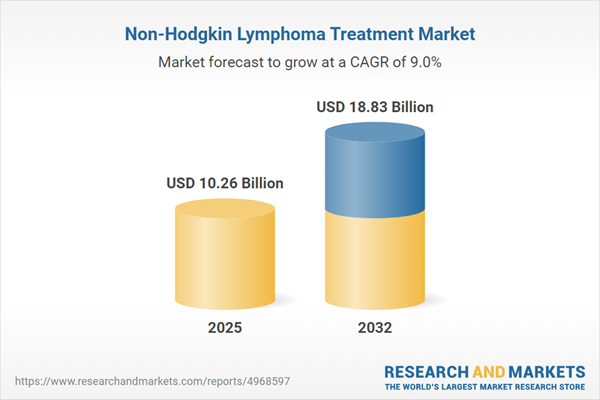Speak directly to the analyst to clarify any post sales queries you may have.
The Non-Hodgkin Lymphoma Treatment Market is experiencing marked transformation, propelled by major scientific advances, changing care delivery paradigms, and evolving regulatory environments. Senior decision-makers in the pharmaceutical and biotechnology sectors must understand this dynamic landscape to identify drivers of growth, regional opportunities, and critical operational risks.
Market Snapshot: Non-Hodgkin Lymphoma Treatment Market
From 2024 to 2025, the Non-Hodgkin Lymphoma Treatment Market expanded from USD 9.46 billion to USD 10.26 billion. Bolstered by an anticipated compound annual growth rate (CAGR) of 8.97%, the market is forecast to reach USD 18.83 billion by 2032. This robust growth trajectory highlights clear momentum, driven predominantly by adoption of molecular diagnostics, targeted therapies, and emerging immunomodulatory strategies. Market expansion is further supported by an increasing focus on patient stratification and precision medicine.
Scope & Segmentation
This research report delivers detailed coverage of emerging market trends, pipeline innovations, and operational shifts across discrete segments relevant to stakeholders. Market segmentation spans the following areas:
- Treatment Type: Chemotherapy, Immunotherapy, Radiation Therapy, Stem Cell Transplant, Targeted Therapy.
- Cell Type: B-cell Lymphomas (including Diffuse Large B-Cell, Follicular, Burkitt, Mantle Cell, Marginal Zone); NK-cell Lymphomas; and T-cell Lymphomas (such as Anaplastic Large Cell, Cutaneous, Peripheral subtypes).
- Route of Administration: Intravenous Infusion, Oral, Subcutaneous Injection.
- Patient Age Group: Adult, Geriatric, Pediatric.
- End User: Ambulatory Surgical Centers, Cancer Treatment Centers, Hospitals.
- Region: Americas (North America, Latin America), Europe, Middle East & Africa, and Asia-Pacific regions—each representing distinct regulatory environments and access patterns.
- Companies Profiled: Over 20 leading entities, including AbbVie Inc., AstraZeneca PLC, Bayer AG, BeiGene Ltd., Bristol-Myers Squibb Company, and Novartis AG, among others.
This segmentation enables a comprehensive understanding of evolving clinical and commercial priorities in the Non-Hodgkin Lymphoma Treatment Market.
Key Takeaways for Senior Decision-Makers
- Rapid clinical innovation is shifting the standard of care from broad cytotoxic regimens to more precise immunotherapy and cell-based approaches, accelerating transitions toward patient-centric models.
- Operational agility is increasingly critical as manufacturing strategies and supply chains are pressured by external risks, including evolving tariff policy and regional disruptions.
- Collaborative partnerships among pharmaceutical leaders and biotech innovators are deepening pipelines and accelerating market entry for next-generation therapies targeting high unmet needs.
- Digitally enabled monitoring, adaptive trial methodologies, and remote health platforms are optimizing clinical evidence collection and improving patient management outcomes.
- Regional disparities in access, reimbursement processes, and infrastructure require tailored strategies and stakeholder collaborations to ensure equitable market penetration and sustainable growth.
Tariff Impact: Strategic Considerations for 2025
Anticipated United States tariff adjustments in 2025 introduce complex implications for the entire value chain. Elevated import duties on pharmaceutical inputs could escalate production costs and influence therapy pricing structures. Manufacturers are reassessing supply chain strategies, emphasizing near-market production, regional partnerships, and inventory safeguards to alleviate tariff exposure. These shifts require alignment between industry, payers, and policymakers to balance cost management and patient access.
Methodology & Data Sources
The report is grounded in comprehensive multi-phase research, blending primary interviews with key opinion leaders and payers, real-world utilization data, and secondary sources such as regulatory filings and peer-reviewed literature. Quantitative modeling, including sensitivity analysis on tariff scenarios, supports scenario-based forecasts and actionable intelligence.
Why This Report Matters for Strategic Stakeholders
- Enables precise investment prioritization and cross-functional alignment by mapping evolving R&D and commercial opportunities.
- Supports proactive risk mitigation through insights on regulatory trends and supply chain vulnerabilities.
- Guides targeted regional engagement by analyzing nuanced market drivers, patient needs, and policy shifts across key geographies.
Conclusion
Senior leaders can leverage this comprehensive analysis to fortify their competitive positioning, drive innovation aligned to emerging care pathways, and navigate the complex intersection of scientific, regulatory, and market forces shaping the Non-Hodgkin Lymphoma Treatment Market.
Additional Product Information:
- Purchase of this report includes 1 year online access with quarterly updates.
- This report can be updated on request. Please contact our Customer Experience team using the Ask a Question widget on our website.
Table of Contents
3. Executive Summary
4. Market Overview
7. Cumulative Impact of Artificial Intelligence 2025
Companies Mentioned
The companies profiled in this Non-Hodgkin Lymphoma Treatment market report include:- AbbVie Inc.
- AstraZeneca PLC
- Bayer AG
- BeiGene, Ltd.
- Bristol-Myers Squibb Company
- Cipla Inc.
- Dr. Reddy’s Laboratories Ltd.
- Eli Lilly and Company
- F. Hoffmann-La Roche Ltd
- Gilead Sciences, Inc.
- GlaxoSmithKline PLC
- Hikma Pharmaceuticals PLC
- Intas Pharmaceuticals Ltd.
- Kyowa Kirin Co., Ltd.
- Lupin Ltd.
- Merck & Co., Inc.
- Novartis AG
- Salvavidas Pharmaceutical Pvt. Ltd.
- Sanofi S.A.
- Takeda Pharmaceutical Company Limited
- Teva Pharmaceutical Industries Ltd.
- Zydus Pharmaceuticals
Table Information
| Report Attribute | Details |
|---|---|
| No. of Pages | 190 |
| Published | November 2025 |
| Forecast Period | 2025 - 2032 |
| Estimated Market Value ( USD | $ 10.26 Billion |
| Forecasted Market Value ( USD | $ 18.83 Billion |
| Compound Annual Growth Rate | 8.9% |
| Regions Covered | Global |
| No. of Companies Mentioned | 23 |









